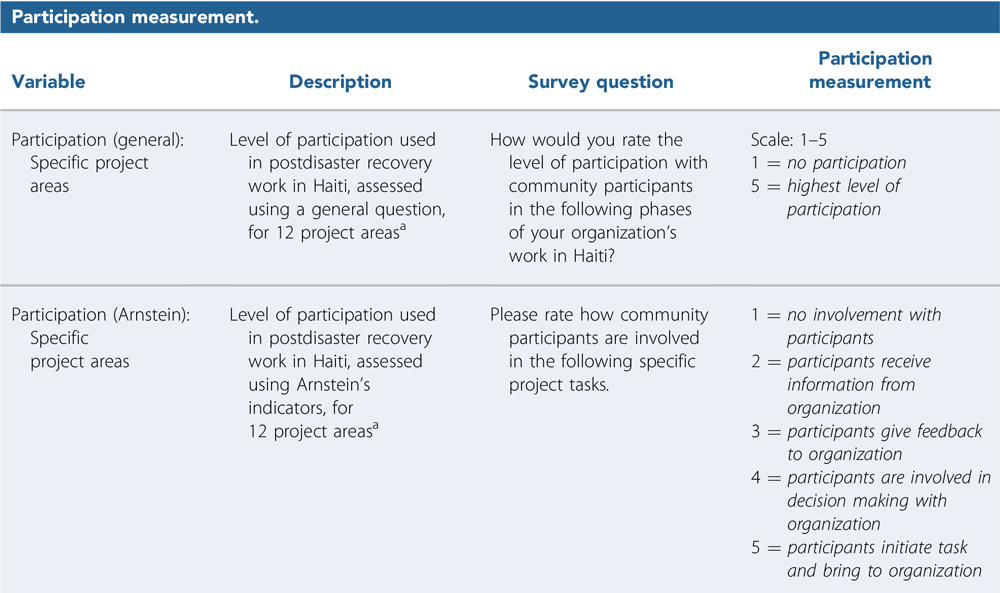Uncovering JAPA
A Ladder to More Meaningful Community Participation

Over the last 50 years, Arnstein's ladder has become the touchstone for assessing community participation. Planners discuss the ladder's significance to the discipline but struggle to put it into practice.
And so, the question becomes how do planners use Arnstein's Ladder of Citizen Participation not just as an ideal but as a foundation to shape their engagement? And would such an approach make a difference?
In her article "Using Arnstein's Ladder as an Evaluative Framework for the Assessment of Participatory Work in Postdisaster Haiti," Journal of the American Planning Association (Vol. 85, No. 3), author Santina Contreras suggests that the potential for the ladder has yet to be realized.
The post-disaster setting offers particular promise for the ladder. Here, participation presents an opportunity for communities to transform their spaces — prioritize their values, and promote equity.
Participation in Post-Disaster Recovery Programs
However, as Contreras reveals, this is complicated in countries like Haiti, which receive a large portion of their post-disaster recovery assistance not from the government but from international nongovernmental organizations (NGOs). These organizations often do not have established relationships with communities, yet recognize community participation "helps planners understand local public knowledge, assists in identifying recovery needs, contributes to the dynamic exchange of information, and promotes the consolidation of diverse perspectives."
It remains possible that these organizations merely reproduce unequal power relationships.
In her study, Contreras conducted a survey of 296 organizations working in post-disaster Haiti evaluating their participation through two indicators. The first asks organizations to rate their participatory practices from 1 (no participation) to 5 (high participation) across 12 project areas. For the second indicator, Contreras again asked organizations to rank their participation from 1 to 5, this time with each number corresponding to the language Sherry Arnstein used to describe rungs on her ladder of participation.
Regardless of the indicator, having organizations self-report their level of community participation was likely to lead to higher numbers than if identified by community members themselves or third-party observers.
Accounting for this, Contreras took multiple precautions. She administered her questionnaire online, spreading participatory questions throughout, asking organizations to discuss not the outputs of their work but rather the activities they did with communities to promote participation. Lastly, Contreras ensured organizations' anonymity as part of participation.

Table 4: Participation measurement from "Using Arnstein's Ladder as an Evaluative Framework for the Assessment of Participatory Work in Postdisaster Haiti," Journal of the American Planning Association (Vol. 85, No. 3). Note: a. Project areas: 1) Discussion of problems in the community; 2) assessing potential solutions to problems for project development; 3) project design; 4) selection of the project site; 5) project scale; 6) timeline decisions; 7) funding decisions; 8) decisions on how the community will contribute to the project; 9) implementation of the project; 10) supervision of work; 11) project modification; 12) project evaluations.
Post-Disaster Recovery: Participation Levels Vary
Ultimately, Contreras found that organizations reported high levels of participation with an average of 3.73 organizations using the first indicator. This changed when Contreras used the language of Arnstein's ladder. Using this indicator, organizations reported an average participation score of 3.42, suggesting that most organizations did not identify themselves as engaging in participatory actions beyond "participants give feedback to organization," equivalent to Arnstein's definition of tokenism.
So while organizations are participatory, they seldom reach the highest level of community participation, which Contreras defines as "participants initiate a task and bring to the organization."
Contreras's findings illustrated that the level of participation varied based on the actions undertaken by the organization.
Project areas through which organizations would likely have the greatest amount of control (i.e., funding decisions) demonstrated the lowest level of community participation, with a participation level of 2.39 reported on the indicator using Arnstein's ladder.
This suggests that communities do not participate beyond receiving information from organizations. Therefore, the project areas that lend themselves best to addressing past inequities are the areas in which communities experience the greatest exclusion.
Additionally, Contreras discovers that participation is not equal across recovery sectors. Organizations involved in the children/youth, health, and rebuilding/reconstruction sectors showed the lowest degree of community participation. This proves troubling when over 60 percent of participating organizations reported being involved in children/youth and health and over 40 percent listed rebuilding/construction.
Contreras reevaluates the way we approach community participation. She suggests that perhaps Arnstein's ladder provides a way for planners to be more rigorous in evaluating participatory actions.
I believe her focus on international, post-disaster contexts underscores this importance. Because in these spaces, without existing relationships, with perhaps language barriers, planners run the risk of exploiting communities for their labor without seeking any of their input during the rebuilding process. So while the ladder cannot fix community participation, it surely provides a space from which to start.
Top image: In January 2018, partners in Haiti of the nonprofit organization IRI discussed how to promote citizen participation and effective inclusion in municipal decision-making. Photo courtesy IRI Twitter feed.


